When I met our dedicated Wheel Tracks editor, Gary “Scoop” Fiske, at the Stowe Show, he reminded me that it is “my” month. Uh oh, I’m in Stowe, the computer at home in Milton, ideas, nil. As the show went on, RAIN and shine, I decided that what better topic than to tout the organizers of this event. To most folks, this is a great show that “just happens” in mid August and is greatly enjoyed by casual spectators as well as rabid car enthusiasts. What is probably not generally realized is that it is the culmination of a full year of monthly meetings by the show committee to plan, organize, arrange, and try to anticipate whatever may or may not come up. These organizers have many years of experience to draw upon and are a totally awesome and dedicated group. Then during the week of the show’s opening, the field has to be set up, signs put up, packets prepared, get media coverage, food prepared for workers, sound system setup, parking area ropes and signs for show cars and the public, car corral setup, flea market setup, a plan for weather changes, places for visitors to sit and rest, golf carts ready, contacting and confirming the Stowe Fire Department, EMT and police presence, port-a-pot folks, trash pickup (what a great job they do), constantly being available to solve whatever problems arise on the spot – all that and more! Then comes the inglorious task of taking down and packing up everything, maybe getting a little break, be-fore starting plans for next year’s show. Whew!!! There just are not enough good things that can be said for Bob Chase and Duane Leach’s leadership, but I’ve tried, lest they think no one is aware of all they do, as they, literally, run from one situation to another. We realize that whatever the weather brings, or what problems arise, the Show will go on and will be spectacular. Thank you from the softer side! Marnita, you are awesome as well!!
Year: 2012
Ethanol does it, again! – Dave’s Garage
Several weeks ago I was mowing the lawn with my trusty 1978 Sears lawn tractor, when the engine suddenly sputtered and quit. I also smelled gas. A quick look under the hood revealed a split fuel hose. I replaced the hose, but noticed the leaking hose actually rotted out from the inside out. Another Ethanol problem. I was toying with the idea of writing an article about the fuel system in older cars and how to avoid problems with Ethanol.
My recent experience with the Stowe Car Show has a few Ethanol stories. Saturday morning a few people walked up to me and told me that my Volkswagen smelled of gasoline. A quick inspection revealed that there was gas leaking from the rubber hose that goes from the metal pipe in the floor pan to the engine. The leaking gasoline had actually caused the paint on the frame to bubble up and peal down to bare metal. When I restored this car in ’94, I had the floor pan painted with DuPont Imron urethane paint. At the time, it was considered to be just about the toughest, most resilient industrial paint on the market. I am quite upset that my beautiful floor pan now has paint bubbling up and falling off.
After a quick trip to a friendly and helpful flea market vendor, I crawled under the car to replace the hose. At the lowest part of the hose, the rubber was actually dry rotted away. Obviously, the cloth braided Volkswagen fuel hose is not Ethanol compatible. Later in the day I was trying to help a model T owner start his car. His carburetor was leaking gasoline. The float bowl gaskets were not Ethanol compatible, and neither was his float valve. The valve was sticking closed, then open.
So now what do we do? Modern fuel line is made out of neoprene, and is Ethanol compatible. I prefer to use fuel injection hose. It costs more, but lasts longer. Make sure when you order a carb kit or a fuel pump you buy a newer kit that is Ethanol compatible. I knew about carburetor gaskets not being ethanol compatible, but I was unaware of the problem with the needle and seat float valves. The old brass ones are ok, but the valves made with plastic and rubber parts may not be.
Gas tanks and metal fuel lines are probably ok, but a lot of the gas tank sealers sold until quite recently are not Ethanol compatible. Another problem is zinc parts. Apparently, zinc can be corroded by Ethanol.
Ethanol gas is a great solvent, and will remove gum, varnish and crud in the fuel system. This will plug up lines and filters. It is also a good idea to check filters more often.
Lastly, keep this stuff away from all paint work. It is also a great paint remover.
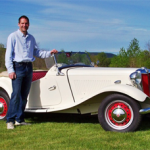 Please email all inquiries to: Dave
Please email all inquiries to: Dave
or snail mail
32 Turkey Hill Road
Richmond VT 05477
Veteran Stowe Vendors
Stowe Show Vendors… here are four of the 250 who brought their wares to this year’s Show. What makes them so special? They have been coming to our show for nearly 40 years.
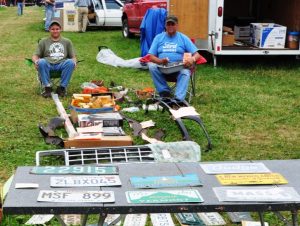 It was Chuck Haynes’ birthday on the 10th of August, the first day of the 2012 Stowe Car Show. It was also his 37th time coming to the Stowe Show to sell his wares. Chuck, pictured on the right, has been a long time VAE member and was president in 1970. He has seen many changes in our club and has helped guide the VAE to the great club that we are today. Chuck’s son, Paul (on the left) has plans to carry on when his dad decides to slow down.
It was Chuck Haynes’ birthday on the 10th of August, the first day of the 2012 Stowe Car Show. It was also his 37th time coming to the Stowe Show to sell his wares. Chuck, pictured on the right, has been a long time VAE member and was president in 1970. He has seen many changes in our club and has helped guide the VAE to the great club that we are today. Chuck’s son, Paul (on the left) has plans to carry on when his dad decides to slow down.
Chuck specializes in Ford parts and has a 5000 sq. foot warehouse in Montpelier. He sells mainly on Ebay where he renews his listings every Friday, his Ebay handle is vtcarnut.
A car delivery in 1966 started him on his Ford journey. While working for a dealership in Haverhill, NH the owner sold a Model A to a customer in Chicago. The buyer wanted it ‘driven’ to Chicago to be sure the seller was telling the truth about the car and Chuck was chosen to make the 1000 mile drive. While driving through Detroit he decided to stop at the Ford plant with his Model A to see if he could get a fifty-cent tour. This led to a job offer and employment at Ford Motor Company. The big city and big business did not mix well with Chuck’s country background and he soon returned to New England where he was involved in many other adventures in his 68 years. Some of us might remember an auto parts store by the name of Daltons on Hoyt Street in St. Albans. The store opened in 1922 and closed in 2005….Chuck purchased the inventory and spent 14 months moving it all to his warehouse. Can you imagine visiting Chuck’s warehouse?
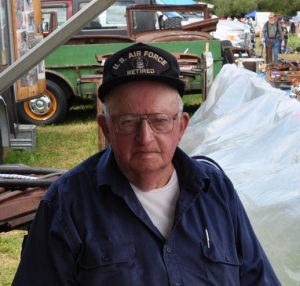 Walt Rodiman (left) became a Stowe Show vendor in 1976. A retired Air Force gent and a dealership parts man is most likely what led Walt into his vendor journey. In years past, Walt has spent his summer traveling to as many as 16 car shows. He claims the Stowe Car Show is one of the best. When asked why, he points to the people passing by and says “look at the big crowd and there are no fights…everyone is happy”. Walt has 6 spaces and makes three trips from Piermont, NH to fill them before the show…and full they are. It didn’t take long to discover that Walt ‘knows his parts and his cars’ as customers had all kinds of questions for him. It also didn’t take long to find that Walt is as honest as they come. Customers would have a part in their hands ready to purchase and Walt would be telling them they would be wasting their money by buying the item because it would not fit on their car. Walt has two sons, Michael and Wayne. We all hope his Stowe vendor tradition will continue another 36 years. When asked if he could do something better than the sober expression when his picture was taken he replied if we want him to smile we should wave a one hundred dollar bill in front of him. We all had a big laugh. Good luck to you Walter Rodiman.
Walt Rodiman (left) became a Stowe Show vendor in 1976. A retired Air Force gent and a dealership parts man is most likely what led Walt into his vendor journey. In years past, Walt has spent his summer traveling to as many as 16 car shows. He claims the Stowe Car Show is one of the best. When asked why, he points to the people passing by and says “look at the big crowd and there are no fights…everyone is happy”. Walt has 6 spaces and makes three trips from Piermont, NH to fill them before the show…and full they are. It didn’t take long to discover that Walt ‘knows his parts and his cars’ as customers had all kinds of questions for him. It also didn’t take long to find that Walt is as honest as they come. Customers would have a part in their hands ready to purchase and Walt would be telling them they would be wasting their money by buying the item because it would not fit on their car. Walt has two sons, Michael and Wayne. We all hope his Stowe vendor tradition will continue another 36 years. When asked if he could do something better than the sober expression when his picture was taken he replied if we want him to smile we should wave a one hundred dollar bill in front of him. We all had a big laugh. Good luck to you Walter Rodiman.
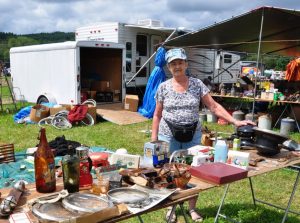 Our next feature vendor is Denise Labrecque from Lyndonville, Vermont. This might be the last Stowe Car Show for Denise unless her son Richard decides to continue. Denise and her husband Rene started coming to our show many years ago and some-times covered 20 others in one summer. Denise lost Rene seven years ago and thinks this might be her last year. She has continued these last seven years by loading her car with only what treasures she can lift and with a little help from her vendor neighbors, she has stayed in business. In fact her Stowe Show neighbors have become such good friends over the years they insist that she spend the nights with them. The only comment from them when asked was how great of a lady Denise is. We hope to see you next year Denise….you can’t quit now!
Our next feature vendor is Denise Labrecque from Lyndonville, Vermont. This might be the last Stowe Car Show for Denise unless her son Richard decides to continue. Denise and her husband Rene started coming to our show many years ago and some-times covered 20 others in one summer. Denise lost Rene seven years ago and thinks this might be her last year. She has continued these last seven years by loading her car with only what treasures she can lift and with a little help from her vendor neighbors, she has stayed in business. In fact her Stowe Show neighbors have become such good friends over the years they insist that she spend the nights with them. The only comment from them when asked was how great of a lady Denise is. We hope to see you next year Denise….you can’t quit now!
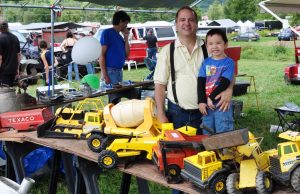 Davey Nadeau has never missed a Stowe Car Show and 2012 was no exception. Mr. Nadeau had been there to set up their booth but was not there on Saturday, he had driven home to Surry, NH to tend his two dogs. His son Bryan and grandson Davey II was holding the fort. This was the five-year-old’s second time at the show and he knew the ropes. A customer asked if they had a certain item and dad Bryan didn’t have a chance. Davey II yelled “I’ll get it dad…I’ll get it” and all dad could do was stand and watch. People would walk by the booth and yell to ask Davey how he was doing and he of course would run out to greet them. Dad said he knew everyone around. Davey II was all business until a little blond girl his age walked by with her parents. When she asked if she could have one of the display balloons a new race began, the little blond girl got 100% of his attention. Brian has been helping his dad Davey for many years and says the Stowe Show is one of their best. He said other shows charge much more and very few allow them to stay the night on the grounds. He said they had done very well so far into the weekend. Brian’s business when there are no vendor shows is restoring cars for resale. One last Davey II story…. During the interview dad Bryan started laughing and pointed out one of his son’s ways to start a conversation with strangers. He had just gone up to some passersby and asked if they had seen his father.
Davey Nadeau has never missed a Stowe Car Show and 2012 was no exception. Mr. Nadeau had been there to set up their booth but was not there on Saturday, he had driven home to Surry, NH to tend his two dogs. His son Bryan and grandson Davey II was holding the fort. This was the five-year-old’s second time at the show and he knew the ropes. A customer asked if they had a certain item and dad Bryan didn’t have a chance. Davey II yelled “I’ll get it dad…I’ll get it” and all dad could do was stand and watch. People would walk by the booth and yell to ask Davey how he was doing and he of course would run out to greet them. Dad said he knew everyone around. Davey II was all business until a little blond girl his age walked by with her parents. When she asked if she could have one of the display balloons a new race began, the little blond girl got 100% of his attention. Brian has been helping his dad Davey for many years and says the Stowe Show is one of their best. He said other shows charge much more and very few allow them to stay the night on the grounds. He said they had done very well so far into the weekend. Brian’s business when there are no vendor shows is restoring cars for resale. One last Davey II story…. During the interview dad Bryan started laughing and pointed out one of his son’s ways to start a conversation with strangers. He had just gone up to some passersby and asked if they had seen his father.
They of course were ready to help when he points toward Bryan then asked how they were doing.
The 40s (Part I)
Wartime saw many restrictions in fashions and clothing in general. The United States stipulated the amount and types of fabric that also affected European nations. With nylon, wool, and silk in short supply, women were forced to turn to fabrics such as rayon crepe, black faille and velvet chiffon for evening clothes. Rayon gabardine was the replacement for wool.
As a direct result of wartime restrictions standardized button and pocket limitations were introduced. Women’s clothing became much more masculine as boxy suit jackets with large shoulder pads, fitted waists, and dresses sported a peplum with narrow skirts. Later on the A line skirt was shown with suits.
Hollywood still greatly influenced the American fashion world and the forty films were filled with the fashions of the time; Suites, sweaters, skirts, pants, bathing suits, shoulder pads and sweater sets were made famous by Rita Hayworth and Lana Turner.
In the evening beaded sweaters and jackets were the choice as sequins were un-rationed and were widely used along with rhinestone buttons. Costume jewelry was large, consisting mostly of pins and brooches made in sterling silver.
Expensive gloves were replaced with knitted or crocheted ones. Stockings were thick rayon. Pocket books were tremendous in size, elongated, and with the metal shortage, made with wood or plastic closures.
Broadcloth or calfskins were used with many women crocheting their own with gimp or cording. Crocheted bags were manufactured in great numbers along with envelope bags, panier handle bags, pearlized plastic bags and hatbox bags, all designs of the forties.
(Read more in Part II…)
Could this be a dream?
I want to tell you about the perfect car tour I was on recently. We stayed in a hotel that had once been a single family “summer home”. The living areas were plush and cozy. My room was quite spacious and the height of comfort with a lounging area and the most remarkable bathroom, equipped with all the “necessaries” and a large soaking tub with the most fabulous shower you have ever seen! I could go on and on about the accommodations but we are on a car tour aren’t we?
In the morning, we would gather for breakfast and listen to the tour guide tell the days agenda. I must tell you the breakfast was just fabulous, a large assortment of muffins, scones, pastries, fresh fruit, yogurt, maple granola and coffee, tea and juice of your choice. The day’s tour was a short ride to the resort’s spa where you could have a pampered day filled with massages, manicures, pedicures and of course, lunch. There is a place provided for anyone (probably the men) to park their cars and walk around them and talk and talk and take a few pictures and I guess I did say talk didn’t I? Then the short ride back for “happy hour” and get in a little more talk before dinner. Dinner and then back to our luxurious rooms for a little TV and a good night’s sleep preparing for day 2.
Day 2 – We gather for the same wonderful breakfast and briefing for the day. Today we take a short drive to the local flea market known for its’ many artists, crafters, and a wonderful food market where we will have lunch. Of course, there is a place to park the cars and let (probably) the men, walk around and talk and meet more men and talk, take a few more pictures and talk a bit more before heading back to our wonderful accommodations and have dinner. A little after dinner talk and by now there are some repairs or tweaks to be made to the cars and some discussion on how to make them. Another day gone and a good night’s sleep needed. We leave everyone today. The goodbyes take time and the next tour is discussed and we say goodbye until next time. You would think this is the “dream” car tour and you would be right! It was just a dream. So boring!!
The Importance of Regular Maintenance – Dave’s Garage
Recently, I went to Rochester, NY for the New England MG “T” Register’s Gathering of the Faithful car show. I decided to take advantage of this trip to also bring my boys, my wife, two of my nieces and my parents to see Niagara Falls. That’s eight people with luggage if you’re counting…
How can I fit eight people in a seven passenger van? In the Chrysler minivans manufactured before the 2005 model year, the seats can be moved around. The three person bench seat can easily be moved up to the center row in place of the two captains chairs. So… It only made sense that I could take out the captains chairs, and add a second three person bench seat. A quick trip to Rathe’s salvage and I was all set. Comfortable, safe seating for eight, with ample leg room and everybody was belted in.
Anyway… Several days before the trip I was returning from Home Depot with a load of Sheetrock and lumber in my Chrysler minivan and the muffler fell off.
While the van was on the lift for the muffler replacement, I decided to give the vehicle a quick safety inspection before the 1,000 plus mile trip.
The van had just been inspected less than 3,000 miles ago, so I was not expecting any issues. A quick inspection of the brakes showed no surprises. Tires looked good. Tire presses were ok. All fluid levels were fine. Front end inspection, VERY LOOSE RIGHT BALL JOINT! It was just about to let go!
The van drove fine, no noticeable noise or movement in the front end. How could this happen?
When I took the old ball joint out, I could see that the cup was broken. It obviously failed fairly quick-ly. The surprising thing is that it gave no symptoms. The scary thing is that wheel was one good bump away from falling off, potentially at interstate speed with eight people on board.
The lesson learned? Pay close attention to your car. Inspect it regularly, especially before any major trips. Fortunately, a major and potentially fatal catastrophe was avoided with twenty minutes of work and less than $50.00 in parts. By the way, my new Harbor Freight Press is working quite well…
 Please email all inquiries to: Dave
Please email all inquiries to: Dave
or snail mail
32 Turkey Hill Road
Richmond VT 05477
Peveril Field Peake – A founder of the VAE
I didn’t know the man, he died in 2007 at the age of 79, but after talking to many of his friends I wish I had. The first Wheel Tracks newsletter in May 1953 contained a three page written by Pevy about a trip with his friend to Pennsylvania in his Model T. A good beginning to get to know Pevy. Here are the first two paragraphs:
The fun part of this project was listening to the ’Pevy stories’ from his friends, some I can not print. Doris Bailey told about the day that Pevy and his friend John Keefer was on a trip to Boston in his Model T (from Bristol no less). While driving through a village they spotted a neat pile of leaves on someone’s lawn and decided to drive the ‘T’ through them. The leaves went flying everywhere. On their way back the same leaves were again raked into a neat pile but this time an anvil had been hidden in them. Yes, you guessed it….they drove through the leaves the second time and the anvil did a job on the car while someone was watching through a curtain slit in the house. The car made it home but you could tell the ‘T’ has issues. Lloyd Davis tells about the day Pevy sold his 46 Caddy to Adrian West but found he had mistakenly agreed to sell it for way less than its value. While Pevy drove the Caddy to it’s new home with Adrian following he was still mulling over his mistake taking many detours on the way. Adrian finally took the lead and the Caddy made it to Morrisville. Bill Sander has the car today, a picture of it can be seen on page 16. Lloyd also tells about the used VW Beetle that was delivered to Pevy back when the car was first introduced to this country. It had stayed in the driveway for a number of days before Pevy figured out how to get it into reverse. I am told Pevy had quite an Irish temper. He had been known to ‘beat-up’ a car when it refused to start. In one mid-winter story the car actually started after its tires and hood got a thrashing. VAE member Joe Kailin is originally from the New York City area. Joe tells about the day he heard a recent story about some New Yorker running Pevy and his Model T off the road. Meeting Pevy for the first time, Joe pretended he was the New Yorker but seeing the Irish temper come across Pevy’s face Joe immediately told Pevy he was joking. Later when the two became good friends, Joe invited Pevy to go with him to visit family in the city. New York City found out what real snoring was that first night Pevy went to sleep!
Pevy was a serviceman for the Oldsmobile dealer in Middlebury for some time and spent many years working as a quality control person at GE in Burlington. Pevy was a very intelligent man and had an encyclopedic memory. All whom I talked with remembers his ability to recall the smallest details of anything including cars.
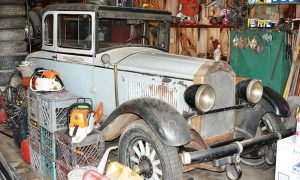 Pevy owned a 28 Willys Knight and in 1957 he entered the car in the first Stowe Antique and Classic Car Show. The main reason, I am told, that he bought the car was because it had a ‘hot water heater’ and that was good for the Vermont winters. The car also has a 9 quart oil sump because it has a sleeve valve type engine and Pevy found out all that oil gets thick when it is cold out and starting the engine is a task. He could be heard a mile away when the car would not start. The car was passed around and traded among VAE members over the years and today sits in a barn in northern Vermont. Pevy paid $35.00 for the car in 1953 when he bought it from someone in New York, the present owner paid Pevy $12.00 in the early 60s for it. VAE names like Chuck Hill, George Farr, Gael Boardman and Lloyd Davis come up as either owning or ‘using the car a lot’.
Pevy owned a 28 Willys Knight and in 1957 he entered the car in the first Stowe Antique and Classic Car Show. The main reason, I am told, that he bought the car was because it had a ‘hot water heater’ and that was good for the Vermont winters. The car also has a 9 quart oil sump because it has a sleeve valve type engine and Pevy found out all that oil gets thick when it is cold out and starting the engine is a task. He could be heard a mile away when the car would not start. The car was passed around and traded among VAE members over the years and today sits in a barn in northern Vermont. Pevy paid $35.00 for the car in 1953 when he bought it from someone in New York, the present owner paid Pevy $12.00 in the early 60s for it. VAE names like Chuck Hill, George Farr, Gael Boardman and Lloyd Davis come up as either owning or ‘using the car a lot’.
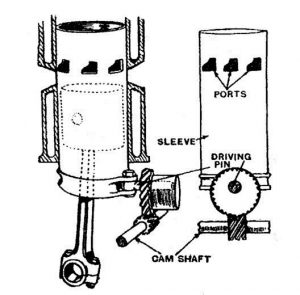 The valve sleeve engine was invented by Charles Knight in 1905 with smaller engines still using the technology today. Mr. Knight was annoyed by the noise the ‘puppet valve’ type engine made and developed this very quiet engine. The 6 cylinder engine has a ‘vacuum operated oil rectifier’ that recovers the oil before it gets burned and goes out the tail-pipe. One VAE member remembers a picture of a Willys Knight with a caption asking how one would know if the car was running or not. The hint in the picture was the plume of smoke that billowed from the rear of the car. The rectifier worked great but would get plugged easily thus causing the blue smoke. The big question I have now is….will I be seeing this 1928 Willys Knight in any future Stowe Car Show? I hope I do.
The valve sleeve engine was invented by Charles Knight in 1905 with smaller engines still using the technology today. Mr. Knight was annoyed by the noise the ‘puppet valve’ type engine made and developed this very quiet engine. The 6 cylinder engine has a ‘vacuum operated oil rectifier’ that recovers the oil before it gets burned and goes out the tail-pipe. One VAE member remembers a picture of a Willys Knight with a caption asking how one would know if the car was running or not. The hint in the picture was the plume of smoke that billowed from the rear of the car. The rectifier worked great but would get plugged easily thus causing the blue smoke. The big question I have now is….will I be seeing this 1928 Willys Knight in any future Stowe Car Show? I hope I do.
Yet Another Use for JB Weld – Dave’s Garage
I like to dabble with models. I have modeled specific cars, and specific trains. When I am working with die cast parts, or need to make a part I often use JB Weld.
Recently, our past VAE president and Wheel Tracks editor Gene Fodor was fortunate enough to find a nice, well used and mostly complete model MG TD (pictured below). Gene decided to restore the model, and model it after his 1953 MG, affectionately named Eliot.
[slide-anything id=’728′]
“Little Eliot” was missing the spare tire, the dashboard decal, and the steering wheel. Gene was able to locate a replacement spare tire and dash decal, but no steering wheel. These steering wheels were a very soft, high lead metal. They were easily broken, as the spokes in the wheel are quite thin.
I took it upon myself to create a new steering wheel for Gene and little Eliot.
- First, I borrowed a similar model to use as a mold for the wheel. I carefully made a relief mold of silly putty, and filled the mold with JB Weld.
- Second, I carefully pealed the silly putty off and cut off the casting slag.
- Third, I took a piece of coat hanger for the steering shaft, hammered a flat on the end, and made a mold for the back side of the wheel. I carefully placed the coat hanger wire in the mold and poured JB Weld in to the mold. The final step was to bend the correct bends in to the shaft, and file and sand the wheel to the proper shape. I have used similar techniques to alter both model trains and cars to copy specific prototypes.
Gene has done a fantastic job with the restoration of little Eliot.
 Please email all inquiries to: Dave
Please email all inquiries to: Dave
or snail mail
32 Turkey Hill Road
Richmond VT 05477
VAE Bridge Celebration
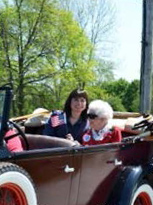 From Granddaughter Kris Trombley… ”My grandmother, Ida Wolcott Wendell, was 15 years old when she attended the Crown Point bridge opening in 1929. She has many memories of the day including having a picnic with her family. She remembers watching the parade at the foot of the bridge on the New York side and remembers seeing, then Gov. Roosevelt in the parade. She also recalls seeing soldiers and scouts in the parade. My grandmother grew up in Crown Point, NY and later moved to Ticonderoga. She married Thomas Wendell. They were married for 72 years before he passed away in 2006. My grandmother was a seamstress.
From Granddaughter Kris Trombley… ”My grandmother, Ida Wolcott Wendell, was 15 years old when she attended the Crown Point bridge opening in 1929. She has many memories of the day including having a picnic with her family. She remembers watching the parade at the foot of the bridge on the New York side and remembers seeing, then Gov. Roosevelt in the parade. She also recalls seeing soldiers and scouts in the parade. My grandmother grew up in Crown Point, NY and later moved to Ticonderoga. She married Thomas Wendell. They were married for 72 years before he passed away in 2006. My grandmother was a seamstress.
Long before the first Crown Point bridge opened, her grandfather, ran the sail ferry transporting passengers between NY and VT. I felt very proud and honored to spend the day with my grandmother as we rode in the parade celebrating the opening of the new Crown Point bridge. Thank you so much.
(This 29er and her Granddaughter rode with Gary & Nancy Olney)
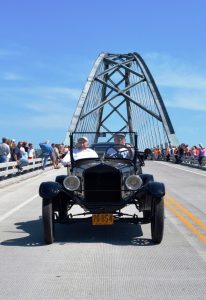 From Gary Fiske… I got lucky at the Bridge Celebration. Bill James of Bristol, VT. agreed to ride with me. I was able to learn just a little of this gentle-man’s 100 years and because of this I will remember him for the rest of my time. Bill will be 101 years old this July. He drives his pickup and Buick where he needs to go, in fact he told me he would be changing the oil in his Buick on Monday… himself! Bill told me while the 1929 bridge was being built he would come by after hours and walk the board cat-walks between the girders to get a close-up view. That is when he found he had no problems with heights and later spent his career as a lineman for the CVPS power company. Bill lost his wife of many years not long ago but has a daughter that he lovingly says ’bosses’ him around and watches over him. This was Bill’s first ride in a Model T. I am not great in crowds but Bill is a natural, waving and smiling to everyone. Bill James made my day.
From Gary Fiske… I got lucky at the Bridge Celebration. Bill James of Bristol, VT. agreed to ride with me. I was able to learn just a little of this gentle-man’s 100 years and because of this I will remember him for the rest of my time. Bill will be 101 years old this July. He drives his pickup and Buick where he needs to go, in fact he told me he would be changing the oil in his Buick on Monday… himself! Bill told me while the 1929 bridge was being built he would come by after hours and walk the board cat-walks between the girders to get a close-up view. That is when he found he had no problems with heights and later spent his career as a lineman for the CVPS power company. Bill lost his wife of many years not long ago but has a daughter that he lovingly says ’bosses’ him around and watches over him. This was Bill’s first ride in a Model T. I am not great in crowds but Bill is a natural, waving and smiling to everyone. Bill James made my day.
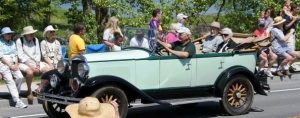 From Wendell Noble… “Our participation in the Champlain Bridge celebration was a great experience for all of us. We wanted to get as many ‘20s vintage cars there as possible to contribute to the historic educational content of the event. Sometime during preparation I realized that my contribution would not be limited by the number of my cars, but finding people to drive them. By enlisting friends and neighbors, I got three cars successfully down and back. A wonderful couple of ‘29ers rode across the bridge in the back seat of my ’29 Plymouth touring car. The front passenger seat was empty though. My wife Mary was nowhere to be found. She had chosen to go up-scale and ride with Christina and Paul McCaffrey in their Bentley. For Lew Zeno, driving my ’29 Plymouth roadster, there were no ‘29ers left so he had a kilted bag piper riding in the rumble seat. Clark Wright did just fine with my ’28 Dodge Bros Coupe until the next day when it succumbed to vapor lock. On our way across the bridge, I heard one spectator say, “That’s amazing, none of them have broken down yet.” I scolded him for such talk.
From Wendell Noble… “Our participation in the Champlain Bridge celebration was a great experience for all of us. We wanted to get as many ‘20s vintage cars there as possible to contribute to the historic educational content of the event. Sometime during preparation I realized that my contribution would not be limited by the number of my cars, but finding people to drive them. By enlisting friends and neighbors, I got three cars successfully down and back. A wonderful couple of ‘29ers rode across the bridge in the back seat of my ’29 Plymouth touring car. The front passenger seat was empty though. My wife Mary was nowhere to be found. She had chosen to go up-scale and ride with Christina and Paul McCaffrey in their Bentley. For Lew Zeno, driving my ’29 Plymouth roadster, there were no ‘29ers left so he had a kilted bag piper riding in the rumble seat. Clark Wright did just fine with my ’28 Dodge Bros Coupe until the next day when it succumbed to vapor lock. On our way across the bridge, I heard one spectator say, “That’s amazing, none of them have broken down yet.” I scolded him for such talk.
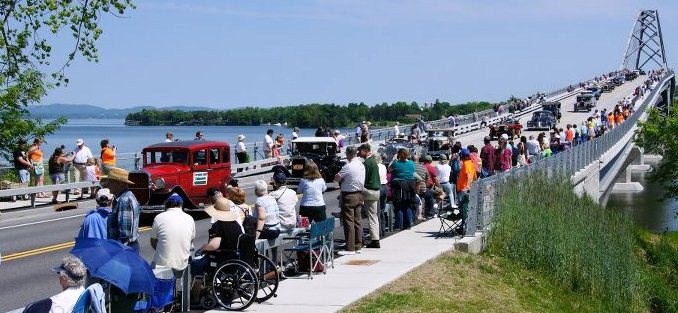
What is “A Survivor”
Being car people, we’ve all heard it, whether it be on one of those showcase auctions like Barrett Jackson, in a feature article in a major magazine such as Hemmings Motor News, or simply a word of mouth story from a friend of a friend with a special car. This automobile is a survivor. It’s all original. The car is an unrestored time machine! These words ring loud throughout the collector car hobby but can mean different things to different people.
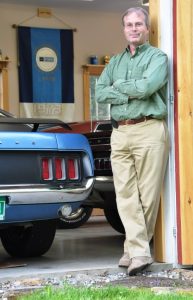 I’ve been obsessed with cars all of my life but didn’t get involved with the collector car hobby until 1995. As the result of an April fool’s joke by my wife that went terribly wrong for her, I purchased what I thought was an all original unrestored 1973 Mustang convertible. After a multi-year restoration process and thousands of dollars less in the checking account I had probably one of the nicest restored cars that I’ve ever set my eyes on. In fact, the car won first place in the Mustang class at the VAE Shelburne Museum show two years in a row. Unfortunately, the love for a restored car just wasn’t there. I sold the Mustang and then began my journey to find a truly un-restored all original survivor. That has led me to my current collection of Mustangs which include a 1969 Shelby GT350, a 1970 Boss 302, a 1973 Mach I, and a 1973 coupe. Are these all original ? Well, some may say yes, but in my opinion, I have to say no. They all had many of the characteristics that people tend to say make them survivors but a true survivor is very rare. What is a survivor ? Simply stated, I look for a car that has original paint and is as it was when it left the factory floor with the exception of minor consumables such as filters, battery, belts, shocks, etc. Obviously, the more consumables in place, the better. Let’s talk about how I would classify my cars.
I’ve been obsessed with cars all of my life but didn’t get involved with the collector car hobby until 1995. As the result of an April fool’s joke by my wife that went terribly wrong for her, I purchased what I thought was an all original unrestored 1973 Mustang convertible. After a multi-year restoration process and thousands of dollars less in the checking account I had probably one of the nicest restored cars that I’ve ever set my eyes on. In fact, the car won first place in the Mustang class at the VAE Shelburne Museum show two years in a row. Unfortunately, the love for a restored car just wasn’t there. I sold the Mustang and then began my journey to find a truly un-restored all original survivor. That has led me to my current collection of Mustangs which include a 1969 Shelby GT350, a 1970 Boss 302, a 1973 Mach I, and a 1973 coupe. Are these all original ? Well, some may say yes, but in my opinion, I have to say no. They all had many of the characteristics that people tend to say make them survivors but a true survivor is very rare. What is a survivor ? Simply stated, I look for a car that has original paint and is as it was when it left the factory floor with the exception of minor consumables such as filters, battery, belts, shocks, etc. Obviously, the more consumables in place, the better. Let’s talk about how I would classify my cars.
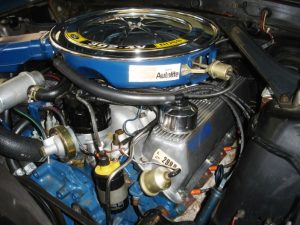 My 1973 Mach 1 and 1970 Boss are what I will call survivors. They have original paint, original interiors, the drive trains are matching numbers, the glass is original, and all of the performance robbing pollution control piece parts are still in place. Okay, so I’m not being quite truthful. The Boss does have a small area on the hood that was repainted to repair a small dent that happened in a parking lot in 1970 ac-cording to the original owner. I’ll still call it a survivor. The repair is part of its history done by the original owner as maintenance.
My 1973 Mach 1 and 1970 Boss are what I will call survivors. They have original paint, original interiors, the drive trains are matching numbers, the glass is original, and all of the performance robbing pollution control piece parts are still in place. Okay, so I’m not being quite truthful. The Boss does have a small area on the hood that was repainted to repair a small dent that happened in a parking lot in 1970 ac-cording to the original owner. I’ll still call it a survivor. The repair is part of its history done by the original owner as maintenance.
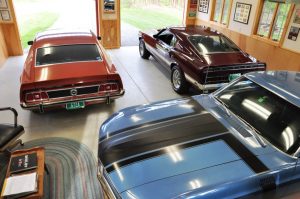 Now, what would I call my Shelby? I can’t call it a survivor. It only has 45,000 miles on it, everything on the car is original, and I even have some of the factory belts and hoses. But alas, the car was re-painted back in the late 70’s by an owner who wanted to keep it looking flawless. I don’t care if the car is 100% original down to the air filter. Once repainted, a car is not a survivor. A repaint also leaves some doubt as to the originality of the body. I’d put this in the class I call unrestored, ie, if selling it I’d say unrestored with one repaint.
Now, what would I call my Shelby? I can’t call it a survivor. It only has 45,000 miles on it, everything on the car is original, and I even have some of the factory belts and hoses. But alas, the car was re-painted back in the late 70’s by an owner who wanted to keep it looking flawless. I don’t care if the car is 100% original down to the air filter. Once repainted, a car is not a survivor. A repaint also leaves some doubt as to the originality of the body. I’d put this in the class I call unrestored, ie, if selling it I’d say unrestored with one repaint.
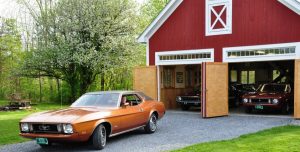 My 1973 coupe has only 7,000 miles on it. Wow ! She just HAS to be a survivor, right ? WRONG ! The car could be what I would call a SUPER survivor in that most of the consumables are still in place. When was the last time you saw an almost 40 year old car with original belts, hoses, shocks, exhaust, muffler, and air filter? I’ll better that, when did you last see a set of Trico wiper blades stamped Made In USA !
My 1973 coupe has only 7,000 miles on it. Wow ! She just HAS to be a survivor, right ? WRONG ! The car could be what I would call a SUPER survivor in that most of the consumables are still in place. When was the last time you saw an almost 40 year old car with original belts, hoses, shocks, exhaust, muffler, and air filter? I’ll better that, when did you last see a set of Trico wiper blades stamped Made In USA !
Unfortunately the original owner had a canoe drop on the hood when it was stored in his garage. That meant a new hood, right front fender, windshield, and the dreaded repaint. Unlike my Shelby, I can’t say the car is unrestored with one repaint. The sheet metal replacement knocks it down a notch. My classification would be preserved with one re-paint.
My passion with all of these cars is that the manufacturing history has not been wiped away by the restoration shop. They have essentially preserved the historic accuracy of factory production cars of the late 60’s and early 70’s. They also hold a story of each previous owner. These were owners that clearly must have had a special relationship with the car. How else would they have managed to survive !










